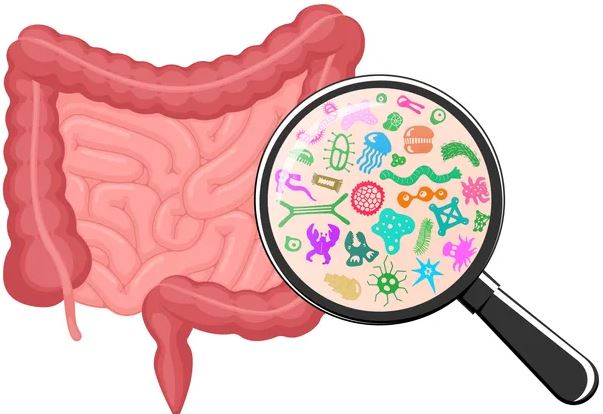Effect of Viruddha Ahara on the Gut Microbiota - A Review
DOI:
https://doi.org/10.21760/jaims.10.9.19Keywords:
Gut microbiome, viruddha ahara, Dysbiosis, Bacterial taxaAbstract
The Gut microbiota, which constitutes the various bacterial flora in our body, plays a vital role in maintaining Homeostasis, Immune balance, Emotional and mental stability and overall health. Disruption of this complex ecosystem is known as “Dysbiosis” which has been implicated in a range of disorders like inflammatory bowel disease, obesity, cardiovascular diseases etc. Among the various factors influencing this, the role of Viruddha Ahara remains to be established. In Ayurvedic literature, Viruddha Ahara refers to incompatible combinations of foods that disturb the physiological equilibrium. This study aims to establish that Viruddha Ahara contributes to dysbiosis through a review of published studies on Gut Microbiota and the effects of dietary behaviour on them. The findings suggest that Viruddha Ahara may act as a factor in gut balance, supporting the integration of Ayurvedic principles in modern gut-based health.
Downloads
References
Country Delight. Country Delight & Indian Dietetic Association did a survey: Why Gut Health is Important? | Dr. Naznin [Internet]. YouTube; 2023 [cited 2025 Jun 16]. Available from: https://www.youtube.com/watch?v=WJMyKskGDdc
Apollo Hospitals. Health of Nation Report [Internet]. 2025 Apr 4 [cited 2025 Jun 16]. Available from:https://www.apollohospitals.com/sites/default/files/2025-04/hon_apollo-hospital04042025-_e-draft.pdf
Vijay A, Valdes AM. Role of the gut microbiome in chronic diseases: a narrative review. Eur J Clin Nutr [Internet]. 2021 Sep 28;76(76):489–501.
Sabnis M. Viruddha Ahara: A critical view. AYU. 2012;33(3):332.
Charaka Samhita. Sutrasthana, Chapter 24: Atreyabhadrakapiya Adhyaya.
Amrut A, Rajaram KS, Pandey R, Vyas M. Desha Viruddha in different regions of India. Int J Ayur Pharma Res. 2014;2(3):17–21.
Mobeen F, Sharma V, Prakash T. Enterotype variations of the healthy human gut microbiome in different geographical regions. Bioinformation. 2018 Dec 31;14(9):560–73.
Arora L, Jallundhara N. A review of Kala Viruddha Ahara in different seasons. J Ayurveda Integr Med Sci. 2020;6:141–4.
Koliada A, Moseiko V, Romanenko M, et al. Seasonal variation in gut microbiota composition: cross-sectional evidence from Ukrainian population. BMC Microbiol. 2020;20:100.
Davenport ER, Cusanovich DA, Michelini K, Barreiro LB, Ober C, Gilad Y. Genome-wide association studies of the human gut microbiota. PLoS One. 2015;10(11):e0140301. doi:10.1371/journal.pone.0140301
Huang G, Wang L, Li J, Hou R, Wang M, Wang Z, et al. Seasonal shift of the gut microbiome synchronizes host peripheral circadian rhythm for physiological adaptation to a low-fat diet in the giant panda. Cell Rep. 2022 Jan;38(3):110203.
Shruti, Nandesh Mohan P, Hadapad HM. Relation between Agni and gut microbiota. J Ayu Int Med Sci. 2025;10(2):118–22. Available from: https://jaims.in/jaims/article/view/4019/
Prabhakaran V, Yadav CR. Genomic insights into the correlation between gut microbiota and Dehagni: a review. Int Res J Ayurveda. 2024;7(8):8–12.
Walkikar SS. Conceptual insights of Matraviruddha Ahara in Ayurveda. J Ayurveda Integr Med Sci. 2023 Jul 29;8(6):203–8.
Aditi P, Srivastava S, Pandey H, Tripathi YB. Toxicity profile of honey and ghee when taken together in equal ratio. Toxicol Rep. 2020;7:624–36. doi:10.1016/j.toxrep.2020.04.002
Zhao J, Zhao F, Yuan J, Liu H, Wang Y. Gut microbiota metabolites, redox status, and the related regulatory effects of probiotics. Heliyon [Internet]. 2023 Nov 1 [cited 2024 Apr 16];9(11):e21431. Available from: https://www.ncbi.nlm.nih.gov/pmc/articles/PMC10643359/
Phuong-Nguyen K, McNeill BA, Aston-Mourney K, Rivera LR. Advanced glycation end-products and their effects on gut health. Nutrients. 2023;15(2):405. doi:10.3390/nu15020405
Zhang P. Influence of foods and nutrition on the gut microbiome and implications for intestinal health. Int J Mol Sci. 2022;23(17):9588. doi:10.3390/ijms23179588
Pillewan MB, Verma AP, Naharia R. Ayurveda concept of Satmya Viruddha and pathological involvement of Madhur and Katu Rasa.
Leeming ER, Johnson AJ, Spector TD, Le Roy CI. Effect of diet on the gut microbiota: rethinking intervention duration. Nutrients. 2019;11(12):2862. doi:10.3390/nu11122862
Jnana A, Murali TS, Guruprasad KP, Satyamoorthy K. Prakriti phenotypes as a stratifier of gut microbiome: a new frontier in personalized medicine? J Ayurveda Integr Med. 2020 Jul;11(3):360–5.
Chauhan NS, Pandey R, Mondal A, Gupta S, Verma MK, Jain S, et al. Western Indian rural gut microbial diversity in extreme Prakriti endo-phenotypes reveals signature microbes. 2018 Feb 13;9.
Rondinella D, Raoul PC, Valeriani E, et al. The detrimental impact of ultra-processed foods on the human gut microbiome and gut barrier. Nutrients. 2025;17:859. doi:10.3390/nu17050859
Sukkur AM, PHS, Mundugaru R, Sudhakara BR. An experimental study of Samskara Viruddha (food incompatibility) with special reference to ghee stored in bronze vessel. J Pharm Sci Innov [Internet]. 2015 Jul 6 [cited 2025 Jun 16];4(3):196–201.
Tang M, Wu Y, Chen G, Olnood G, Gao Y, Wang F, et al. Effects of peroxidized lipids on intestinal morphology, antioxidant capacity and gut microbiome in piglets. Anim Nutr. 2024 Dec 28;20:430–43.
Bao Y, Osowiecka M, Ott C, et al. Dietary oxidized lipids in redox biology: oxidized olive oil disrupts lipid metabolism and induces intestinal and hepatic inflammation in C57BL/6J mice. Redox Biol. 2025 Mar 1;81:103575.
World Journal of Pharmacy and Pharmaceutical Sciences [Internet]. 2015 [cited 2025 Jun 16]. Available from: https://www.wjpps.com/Wjpps_controller/abstract_id/15415
Vandeputte D, Falony G, Vieira-Silva S, et al. Stool consistency is strongly associated with gut microbiota richness and composition, enterotypes and bacterial growth rates. Gut. 2016;65(1):57–62. doi:10.1136/gutjnl-2015-309618
Oliphant K, Allen-Vercoe E. Macronutrient metabolism by the human gut microbiome: major fermentation by-products and their impact on host health. Microbiome. 2019;7:91. doi:10.1186/s40168-019-0704-8
Waclawiková B, Codutti A, Alim K, El Aidy S. Gut microbiota-motility interregulation: insights from in vivo, ex vivo and in silico studies. Gut Microbes. 2022;14(1):1997296. doi:10.1080/19490976.2021.1997296
Chen Y, Yang K, Xu M, et al. Dietary patterns, gut microbiota and sports performance in athletes: a narrative review. Nutrients. 2024;16(11):1634. doi:10.3390/nu16111634
Clarke SF, Murphy EF, O'Sullivan O, et al. Exercise and associated dietary extremes impact on gut microbial diversity. Gut. 2014;63:1913–20.
Jang LG, Choi G, Kim SW, et al. The combination of sport and sport-specific diet is associated with characteristics of gut microbiota: an observational study. J Int Soc Sports Nutr. 2019;16(1):21. doi:10.1186/s12970-019-0290-y
Durack J, Lynch SV. The gut microbiome: relationships with disease and opportunities for therapy. J Exp Med. 2019 Jan 7;216(1):20–40. doi:10.1084/jem.20180448
Terry SM, Barnett JA, Gibson DL. A critical analysis of eating disorders and the gut microbiome. J Eat Disord. 2022;10:154. doi:10.1186/s40337-022-00681-z
Glenny EM, Bulik-Sullivan EC, Tang Q, Bulik CM, Carroll IM. Eating disorders and the intestinal microbiota: mechanisms of energy homeostasis and behavioral influence. Curr Psychiatry Rep. 2017;19(8):51. doi:10.1007/s11920-017-0797-3
Shapla UM, Solayman M, Alam N, et al. 5-Hydroxymethylfurfural (HMF) levels in honey and other food products: effects on bees and human health. Chem Cent J. 2018;12:35. doi:10.1186/s13065-018-0408-3
Patel S, Patel J, Patel M, Sen DJ. Say yes to warm for remove harm: amazing wonders of two stages of water! EJPMR [Internet]. 2019 [cited 2025 Jun 16]. Available from: https://www.ejpmr.com/home/abstract_id/220
Paone P, Cani PD. Mucus barrier, mucins and gut microbiota: the expected slimy partners? Gut. 2020;69(12):2232–43. doi:10.1136/gutjnl-2020-322260. Correction in: Gut. 2023;72(12):e7. doi:10.1136/gutjnl-2020-322260corr1
Adimas MA, Abera BD, Adimas ZT, Woldemariam HW, Delele MA. Traditional food processing and acrylamide formation: a review. Heliyon. 2024 Apr 1;e30258.
Wang Z, Liu H, Liu J, et al. Dietary acrylamide intake alters gut microbiota in mice and increases its susceptibility to Salmonella Typhimurium infection. Foods. 2021;10(12):2990. doi:10.3390/foods10122990
Yu X, Zuo T. Editorial: Food additives, cooking and processing: impact on the microbiome. Front Nutr. 2021;8:731040. doi:10.3389/fnut.2021.731040
Kashikar V, Sirdeshpande M. Critical review on Samyoga Viruddha (combination incompatibility) with special emphasis on carcinogenic effect of combination of betel quid, areca nut and tobacco. AYU. 2017;38(2):97.
Sudhakar KS, Bhat KS. Toxicological evaluation of banana and milk combination as incompatible diet: an experimental exploration of Samyoga Viruddha concept. J Ayurveda Integr Med. 2021 Jul;12(3):427–34.
Hobby GP, Karaduta O, Dusio GF, Singh M, Zybailov BL, Arthur JM. Chronic kidney disease and the gut microbiome. Am J Physiol Renal Physiol. 2019;316(6):F1211–7. doi:10.1152/ajprenal.00298.2018
Maestri M, Santopaolo F, Pompili M, Gasbarrini A, Ponziani FR. Gut microbiota modulation in patients with non-alcoholic fatty liver disease: effects of current treatments and future strategies. Front Nutr. 2023;10:1110536. doi:10.3389/fnut.2023.1110536
Carabotti M, Scirocco A, Maselli MA, Severi C. The gut-brain axis: interactions between enteric microbiota, central and enteric nervous systems. Ann Gastroenterol. 2015;28(2):203–9.
Navarro-Tapia E, Almeida-Toledano L, Sebastiani G, Serra-Delgado M, García-Algar Ó, Andreu-Fernández V. Effects of microbiota imbalance in anxiety and eating disorders: probiotics as novel therapeutic approaches. Int J Mol Sci. 2021;22(5):2351. doi:10.3390/ijms22052351
Sarkar T, Salauddin M, Chakraborty R. In-depth pharmacological and nutritional properties of bael (Aegle marmelos): a critical review. J Agric Food Res. 2020 Dec;2:100081.
Mazumder R, Bhattacharya S, Mazumder A, Pattnaik AK, Tiwary PM, Chaudhary S. Antidiarrhoeal evaluation of Aegle marmelos (Correa) Linn. root extract. Phytother Res. 2006 Jan;20(1):82–4.
Rahman S, Parvin R. Therapeutic potential of Aegle marmelos (L.): an overview. Asian Pac J Trop Dis [Internet]. 2014 Feb [cited 2019 Nov 13];4(1):71–7. Available from: https://www.ncbi.nlm.nih.gov/pmc/articles/PMC4027346/
Karabulut I, Gokbulut I, Bilenler T, et al. Effect of fruit maturity level on quality, sensory properties and volatile composition of two common apricot (Prunus armeniaca L.) varieties. J Food Sci Technol. 2018;55(7):2671–8. doi:10.1007/s13197-018-3189-8
Clarrett DM, Hachem C. Gastroesophageal reflux disease (GERD). Mo Med. 2018;115(3):214–8.
Guan Y, Cheng H, Zhang N, et al. The role of the esophageal and intestinal microbiome in gastroesophageal reflux disease: past, present, and future. Front Immunol. 2025;16:1558414. doi:10.3389/fimmu.2025.1558414

Published
How to Cite
Issue
Section
License
Copyright (c) 2025 Hiranmayi Parthasarathy, Rashma S.

This work is licensed under a Creative Commons Attribution 4.0 International License.














